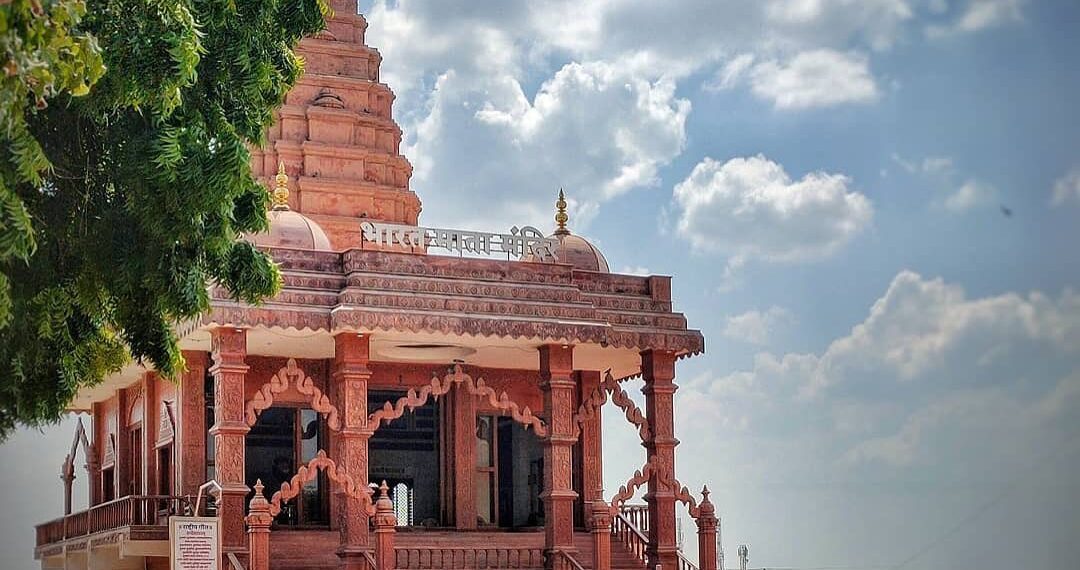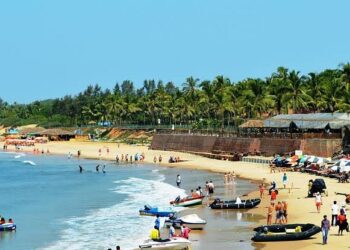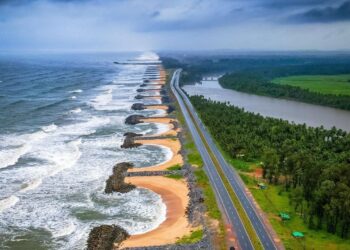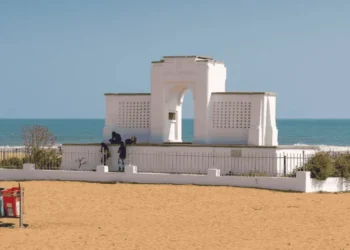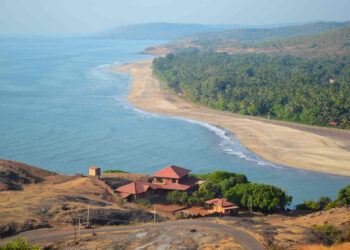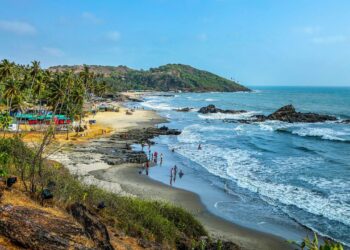Located near the Ganga River in Varanasi, Uttar Pradesh, in the Cantonment area, the Bharat Mata Mandir is a sacred place where people come to pray to Bharat Mata, the mother of India. Unlike typical temples that feature statues of deities, this temple houses a large marble map of Akhand Bharat. It is devoted to Bharat Mata and was once the only temple of its kind in the world, although a few similar temples have since been established.
History of Bharat Mata Mandir
Bharat Mata Mandir was established in 1936 by Shiv Prasad Gupta, a prominent freedom fighter and philanthropist. Located in the most revered city of Varanasi, the temple is also known for its deep connection to Lord Shiva and Hindu heritage. The temple was established in order to light the patriotic spirit during India’s independence movement. As per historical records, Shiv Prasad Gupta envisioned it as a space where citizens could unite in honor of the nation.
The temple is located on level ground within the campus of Mahatma Gandhi Kashi Vidyapith and is accessed by twelve stone steps. During the 1940s, it served as a gathering place for freedom fighters. After India gained independence in 1947, the temple came under the care of a state trust. The temple was inaugurated by Mahatma Gandhi in 1936. Gandhi said: “In this temple there are no statues of gods and goddesses. Here there is only a map of India raised on marble. I hope that this temple will take the form of a worldwide platform for all religions, along with Harijans, and of all castes and beliefs, and it would contribute to feelings of religious unity, peace and love in this country.” Khan Abdul Ghaffar Khan and Vallabhbhai Patel were also present at the inauguration.
Legends of Bharat Mata Mandir
The temple is closely tied to local beliefs and traditional stories about Bharat Mata. One well-known account tells that Shiv Prasad Gupta once saw a dream in which Mother India appeared and asked him to build a temple that would bring people together in unity. Many believe that the spirit of Bharat Mata protects the nation, and that offering sincere prayers at this place brings strength and relief from difficulties, as she is remembered for her role in the freedom movement.
People also believe that the marble map inside the temple holds the very latent power of Bharat Mata.
Some say that singing “Vande Mataram” seven times at the temple gives courage, unity, or help in difficult times. Others believe that the air around the temple carries her protective energy, making it a place where one can feel peace and divine care. On Independence Day, many feel that her spirit is especially strong here, filling the temple with a sense of national pride and devotion.
Architecture of Bharat Mata Mandir
The Bharat Mata Mandir sits on one acre in the Vidyapith campus, made in a plain modern style. The main part has a low marble top, carved with India’s rivers, hills, and flag, all in white marble. Inside, a big marble map of old India, 31 feet by 30 feet, shows rivers like Ganga and hills like Himalayas, lit by daylight. No idol sits here, which makes it different.
A small hall has four marble pillars, carved with freedom marks like the tricolor and spinning wheel. Small shrines for Gandhi, Tagore, and Subhas Bose are in the yard, made of marble. The Gandhi shrine shows him with a stick, for peace. The Tagore one, from 1936, shows him with a pen, for wisdom. The Bose one shows him with a sword, for fight. The marble yard feels holy, near the Ganga. A plain gate has Bharat Mata’s face. A water ghat, Ganga’s edge, is 3 kilometers off for ritual dips. Walls have “Vande Mataram” words carved in Hindi, guiding those who pray. A garden with a banyan tree gives calm.
Rituals and Festivals
Independence Day, August 15, is big, with all-day songs and flag raising. Republic Day, January 26, honors Bharat Mata with lamps. Gandhi Jayanti, October 2, has daily prayers with bhajans.
Independence Day’s songs fill the yard with faith. The Ganga ghat, said to wash sins, pulls crowds nearby. Folks offer flowers, incense, and tricolor cloth. Some sing “Vande Mataram” nine times, taking 1 hour, for special wishes. Free meals feed 2,000–5,000 during festivals.
Information for Travelers
Hours and Entry: The temple is open daily from 9:30 in the morning until 8 in the evening. Entry is free, but offerings for prayers range from a small to a moderate amount. Photography is not allowed inside the main hall.
Clothing: Visitors are advised to wear attire that covers the shoulders and knees. Women typically wear sarees or traditional suits when coming for prayers, while men usually dress in kurtas.
How to Get There:
By Air: The closest airport is Varanasi Airport, located roughly 20 kilometers from the temple. It offers flights to major cities like Delhi and Mumbai. From the airport, taxis take about 30 minutes to reach the temple.
By Train: Varanasi Junction railway station is about 3 kilometers away and connects to cities including Delhi and Lucknow. Auto-rickshaws are readily available for transportation within the city.
By Road: Varanasi is situated on National Highway 27, approximately 300 kilometers from Lucknow. Regular bus services operate between Lucknow and Varanasi. Within the city, auto-rickshaws offer easy access to the temple. Parking is available nearby for a small fee.
Best Time to Visit:
October to March is cool, 15–25°C. Weekdays are quiet. Independence Day’s busy, with 5,000–15,000 visitors, so come early.
Nearby Attractions:
Kashi Vishwanath Temple: 3 km away, a Shiva shrine, a Jyotirlinga.
Sankat Mochan Temple: 4 km away, a Hanuman shrine from the 1500s.
Durga Temple: 4 km away, a Durga shrine from 1700.
Assi Ghat: 5 km away, a bath spot for prayers.
Final Words
Bharat Mata Mandir in Varanasi is a heartfelt tribute to the spirit of Mother India allowing visitors to connect with India’s spiritual heritage. A visit here offers a close experience of Bharat Mata’s divine presence and the sacred history of Varanasi, bringing a deep sense of peace and patriotism.
